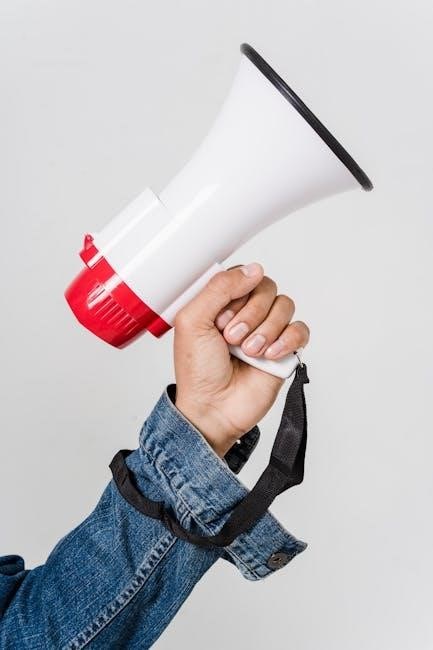Crosley Turntable Manual: A Comprehensive Guide
Welcome to your ultimate resource for Crosley turntable operation! This manual provides essential information for setup, operation, and maintenance.
Crosley turntables offer a blend of vintage aesthetics and modern functionality, appealing to both vinyl enthusiasts and newcomers alike. Known for their diverse range of models, from portable suitcase players like the Cruiser to high-fidelity systems, Crosley caters to various needs and budgets. This guide provides comprehensive instructions for operating and maintaining your Crosley turntable, ensuring optimal performance and longevity. Whether you’re unboxing your first turntable or seeking troubleshooting tips, this manual covers essential aspects such as setup, speed adjustment (including the 45 RPM adapter), Bluetooth connectivity (if applicable), and cleaning procedures. Remember to retain these instructions for future reference, as emphasized in the original documentation, ensuring safety and proper operation. Crosley offers a comprehensive quick start guide with each turntable, which allows users to start playing music quickly. This guide dives deeper into more advanced aspects.
Unboxing and Initial Setup
Upon receiving your Crosley turntable, carefully unbox all components. Typically, the package includes the turntable unit, a power adapter, a user manual, and sometimes a 45 RPM adapter for playing smaller vinyl records. Ensure all listed parts are present; if anything is missing, contact Crosley customer service immediately. Refer to the quick start guide included for a basic overview. Place the turntable on a stable, level surface to prevent skipping or vibration issues. Remove any protective packaging from the turntable and tonearm. Connect the power adapter to the turntable and plug it into a power outlet. Before proceeding, familiarize yourself with the main parts of the turntable, including the platter, tonearm, cartridge, and speed selector. Many Crosley models come with a factory-fitted cartridge, so adjustments may not be necessary initially. However, understanding its function is crucial. Retain the original packaging for potential future transport or returns. Taking these initial steps carefully will ensure a smooth setup process and prevent damage to your new turntable.
Included Parts and Accessories
Your Crosley turntable package typically contains several key components and accessories essential for setup and operation. The most important item is, of course, the Crosley turntable unit itself. This includes the main body, the platter where you place your vinyl records, and the tonearm with a pre-installed cartridge and stylus (needle). A power adapter is always included to provide electricity to the turntable; ensure you use the specified adapter for your model to avoid damage. Most Crosley turntables come with a user manual or instruction booklet. This manual provides detailed information on setup, operation, troubleshooting, and maintenance. A 45 RPM adapter is often included; this small, circular piece is necessary for playing 7-inch vinyl records, which have a larger center hole. Some models may also include additional accessories, such as RCA cables for connecting to external speakers or amplifiers, or a cleaning cloth for maintaining the turntable’s surface. Check the contents against the included parts list in the manual to confirm everything is present. Contact Crosley customer service if any item is missing from the package. Keeping these parts and accessories organized will help ensure a smooth listening experience and proper care for your turntable.
Quick Start Guide Overview
The Quick Start Guide included with your Crosley turntable offers a simplified overview of the initial setup and basic operation, designed to get you playing records as quickly as possible. Typically, it begins with unpacking instructions, guiding you to safely remove the turntable and its components from the box. Next, it outlines the placement of the turntable, advising you to choose a stable, level surface away from vibrations or direct sunlight. The guide then illustrates how to connect the power adapter, ensuring the voltage is correct for your region. It usually includes a diagram showing where to plug in the adapter. Setting up the platter and belt (if applicable) is another key step covered in the Quick Start Guide. This involves placing the platter on the central spindle and, for some models, looping the drive belt around the motor pulley. The guide will show you the correct way to do this. Basic operation, such as powering on the turntable and selecting the appropriate speed (33 1/3 or 45 RPM), is also explained. It will indicate the location of the power switch and speed selector. Finally, the Quick Start Guide often includes a brief troubleshooting section, addressing common issues like skipping or no sound. Remember to consult the full user manual for more detailed information and advanced features. The Quick Start Guide is your express lane to enjoying your vinyl collection!
Operation Instructions
Operating your Crosley turntable is generally straightforward, but understanding the key steps ensures optimal performance and protects your vinyl records. First, ensure the turntable is placed on a stable, level surface to prevent skipping or unwanted vibrations. Before powering on, make sure the platter is correctly seated on the spindle and the drive belt (if applicable) is properly connected to the motor pulley. To power on the turntable, locate the power switch, often integrated with the volume control, and turn it to the “ON” position. Next, select the appropriate speed for your record: 33 1/3 RPM for LPs (long-playing albums) or 45 RPM for singles and EPs (extended plays). Some Crosley models have a speed selector switch, while others may require manually adjusting the belt position on the motor pulley. Carefully place the record on the platter, centering it on the spindle. Remove the stylus protector from the tonearm’s needle. Gently lift the tonearm using the cueing lever (if equipped) or manually, and position it over the beginning of the record. Lower the tonearm slowly onto the record. The music should begin to play. Adjust the volume to your desired listening level using the volume control knob. To stop playback, lift the tonearm from the record using the cueing lever or manually, and return it to its resting position. Secure the tonearm with the tonearm clip to prevent damage during storage or transport. Power off the turntable when not in use to conserve energy and prolong its lifespan. Always handle records with care, holding them by the edges to avoid fingerprints and scratches. Enjoy your vinyl listening experience!
Powering On and Selecting Function
The initial step to enjoying your vinyl collection with a Crosley turntable involves powering on the device and selecting the appropriate function. The power switch is often integrated with the volume control knob, typically located on the front or side panel of the unit. To power on, simply rotate the knob clockwise until you hear a click. The turntable’s indicator light should illuminate, confirming that it’s receiving power. Some Crosley models feature a dedicated power button that needs to be pressed. Once powered on, you’ll need to select the desired function. Crosley turntables often offer multiple playback options, including vinyl, Bluetooth, and AUX input. A function switch, usually a dial or a series of buttons, allows you to choose the source. To play vinyl records, set the function switch to the “PHONO” position. This activates the turntable mechanism and prepares it for record playback. If you wish to connect an external audio device, such as a smartphone or MP3 player, use the “AUX” input setting. For wireless connectivity, select the “Bluetooth” function (if available on your model). Refer to the Bluetooth connectivity section of this manual for pairing instructions. Ensure the function switch is correctly set before proceeding to avoid unexpected behavior or damage to the turntable. If you encounter any issues with powering on or selecting the function, consult the troubleshooting section for potential solutions. Always power off the turntable when not in use to conserve energy and prevent potential damage from power surges. By following these simple steps, you can easily power on your Crosley turntable and select the desired function to begin enjoying your favorite music.
Turntable Speed and 45 RPM Adapter
Crosley turntables are designed to play records at different speeds, primarily 33 1/3 RPM (Revolutions Per Minute) for LPs (Long Play records) and 45 RPM for singles and EPs (Extended Play records). Selecting the correct speed is crucial for accurate playback and preventing damage to your records. Most Crosley turntables feature a speed selector switch, typically located near the tonearm or platter. This switch allows you to choose between 33 1/3 RPM and 45 RPM. Ensure the switch is set to the appropriate speed before placing a record on the platter. Playing a 33 1/3 RPM record at 45 RPM will result in a faster, higher-pitched sound, while playing a 45 RPM record at 33 1/3 RPM will result in a slower, lower-pitched sound. Many 45 RPM records have a larger center hole than LPs, requiring the use of a 45 RPM adapter. This adapter, usually a small plastic disc, fits over the turntable’s spindle and provides a snug fit for 45 RPM records with large center holes. Most Crosley turntables include a 45 RPM adapter, which is often stored in a designated slot near the tonearm or platter. To use the adapter, simply place it over the spindle before placing the 45 RPM record. Some Crosley models may also support 78 RPM records, an older format that requires a different stylus and speed setting. However, not all Crosley turntables are compatible with 78 RPM records, so consult your model’s specifications before attempting to play them. Always handle records with care to avoid scratches or damage, which can affect playback quality. Regularly clean your records and stylus to ensure optimal performance and longevity. By understanding turntable speed settings and utilizing the 45 RPM adapter when necessary, you can enjoy your entire vinyl collection on your Crosley turntable.
Troubleshooting Common Issues
Even with careful setup and operation, you might encounter some common issues with your Crosley turntable. This section provides guidance on troubleshooting these problems to help you get back to enjoying your vinyl. One frequent issue is the needle slipping or skipping across the record. This can be caused by several factors, including a dirty stylus, a damaged record, or an improperly adjusted tonearm. Start by cleaning the stylus with a stylus brush to remove any dust or debris. Inspect your records for scratches or warps that may be causing the skipping. Ensure the turntable is placed on a stable, level surface to prevent vibrations. Another common problem is distorted or muffled sound. This can be due to a dirty stylus, worn-out stylus, or incorrect tracking force. Clean the stylus regularly and consider replacing it if it’s old or damaged. Check the tracking force adjustment on your tonearm, if applicable, and adjust it according to the manufacturer’s recommendations; If your turntable has Bluetooth connectivity, you might experience pairing issues. Make sure Bluetooth is enabled on both the turntable and your audio device. Try unpairing and re-pairing the devices. Ensure the turntable is within range of the audio device. If you’re experiencing motor noise or speed inconsistencies, check the drive belt for wear or damage. Replace the belt if necessary. Ensure the platter is properly seated on the spindle. If the issue persists, the motor may require professional servicing. Power-related problems, such as the turntable not turning on, can be due to a faulty power adapter or a loose connection. Check the power adapter and ensure it’s securely plugged into both the turntable and the power outlet. If the problem continues, try a different power outlet or a replacement adapter. By systematically addressing these common issues, you can often resolve problems with your Crosley turntable and restore its optimal performance. If you’re unable to resolve the issue yourself, consult a qualified technician.
Needle Slipping or Skipping
One of the most frustrating issues you might encounter with your Crosley turntable is the needle slipping or skipping across your records. This can not only interrupt your listening experience but also potentially damage your vinyl. Several factors can contribute to this problem, and systematically addressing them is crucial for resolving it. The most common cause is a dirty stylus. Dust, debris, and microscopic particles can accumulate on the stylus tip, preventing it from properly tracking the grooves of the record. Use a dedicated stylus brush to gently clean the stylus before each use. Brush from back to front, following the direction of play. Avoid using your fingers or other materials, as they can damage the delicate stylus. Another potential cause is a damaged record. Scratches, warps, or imperfections on the record surface can cause the needle to skip. Inspect your records carefully for any visible damage. If a record is severely damaged, it may be beyond repair. Ensure the turntable is placed on a stable, level surface. Vibrations from the surrounding environment can cause the needle to skip. Place the turntable on a solid, non-resonant surface away from speakers or other sources of vibration. The tracking force, which is the amount of pressure the stylus exerts on the record, can also affect skipping. If the tracking force is too light, the needle may not stay in the groove. If it’s too heavy, it can damage the record. Consult your turntable’s manual for the recommended tracking force and adjust it accordingly. Some Crosley turntables have adjustable counterweights for setting the tracking force. The anti-skate control applies a small force that counteracts the tendency of the stylus to be pulled towards the center of the record. If the anti-skate is not properly adjusted, it can cause the needle to skip. Experiment with different anti-skate settings to find the optimal setting for your turntable and cartridge. In rare cases, the stylus itself may be worn out or damaged. If you’ve tried all other troubleshooting steps and the skipping persists, consider replacing the stylus with a new one. By carefully examining these factors and making the necessary adjustments, you can often resolve needle slipping or skipping issues and enjoy uninterrupted playback of your favorite vinyl records.
Pairing with Devices
Maintenance and Care
Proper maintenance and care are essential for prolonging the life of your Crosley turntable and ensuring optimal performance. Regular cleaning, proper storage, and careful handling will help keep your turntable in top condition and prevent potential problems; Dust is the enemy of vinyl records and turntables. Dust particles can accumulate on the platter, tonearm, and stylus, affecting sound quality and potentially damaging your records. Use a soft, anti-static cloth to regularly wipe down the turntable’s surfaces. Avoid using harsh chemicals or abrasive cleaners, as they can damage the finish. The stylus, or needle, is the most delicate part of your turntable. It’s crucial to keep it clean to ensure accurate tracking and prevent damage to your records. Use a dedicated stylus brush to gently clean the stylus before each use. Brush from back to front, following the direction of play. Replace the stylus periodically, as recommended by the manufacturer. A worn stylus can damage your records. Vinyl records should be stored vertically in their sleeves to prevent warping. Keep them away from direct sunlight, heat, and humidity. Handle records by the edges to avoid getting fingerprints on the playing surface. The turntable belt, if your model has one, may need to be replaced periodically. Check the belt for signs of wear or stretching and replace it if necessary. Refer to your turntable’s manual for instructions on replacing the belt. If your turntable has a dust cover, use it when the turntable is not in use to protect it from dust and debris. When moving the turntable, be sure to secure the tonearm to prevent it from moving around and getting damaged. Disconnect all cables and pack the turntable carefully in its original packaging, if possible. By following these simple maintenance and care tips, you can keep your Crosley turntable in excellent condition and enjoy years of listening pleasure. Regular attention to these details will not only improve the sound quality but also extend the lifespan of your equipment and record collection.



Leave a Reply
You must be logged in to post a comment.